Tesco Case Study: Strategic Business Plan, Performance, and Analysis
VerifiedAdded on 2020/07/22
|9
|2643
|37
Case Study
AI Summary
This case study examines Tesco, a prominent retail brand, and its strategic business plan. The report delves into Tesco's performance measurement techniques, including the Corporate Steering Wheel and key performance indicators, and explores its targets for various aspects of the business, such as market development, employee support, and environmental sustainability. It analyzes the implementation of these strategies, emphasizing data-driven customer insights and personalized promotions. The study also covers risk management, environmental analysis, value chain analysis, and customer relationship management (CRM) strategies. Furthermore, the case study provides recommendations for Tesco's future growth, including market analysis, organizational audits, and potential joint ventures. The report concludes with a summary of Tesco's success and its ongoing efforts to improve its business operations and customer engagement.

CASE STUDY “TESCO”
Paraphrase This Document
Need a fresh take? Get an instant paraphrase of this document with our AI Paraphraser
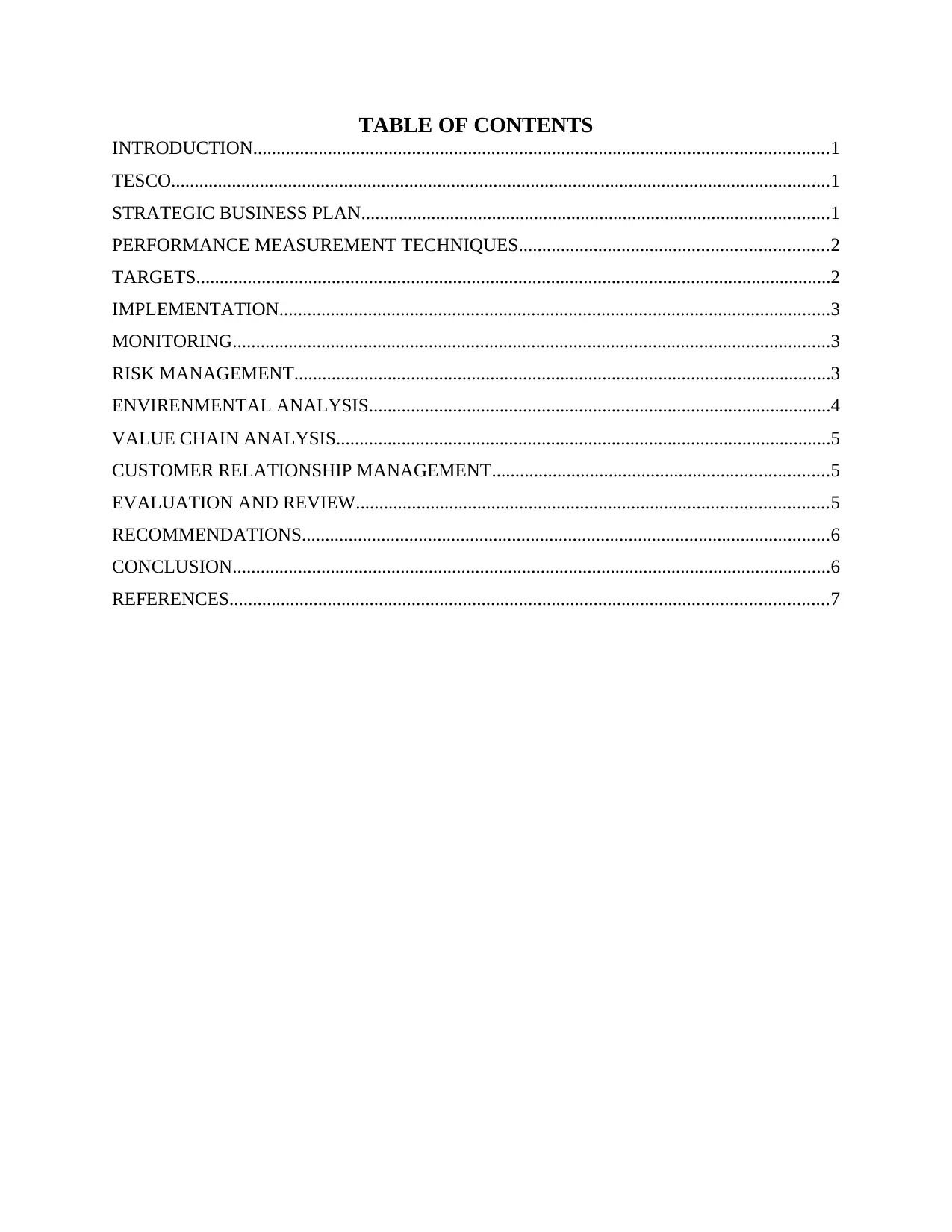
TABLE OF CONTENTS
INTRODUCTION...........................................................................................................................1
TESCO.............................................................................................................................................1
STRATEGIC BUSINESS PLAN....................................................................................................1
PERFORMANCE MEASUREMENT TECHNIQUES..................................................................2
TARGETS........................................................................................................................................2
IMPLEMENTATION......................................................................................................................3
MONITORING................................................................................................................................3
RISK MANAGEMENT...................................................................................................................3
ENVIRENMENTAL ANALYSIS...................................................................................................4
VALUE CHAIN ANALYSIS..........................................................................................................5
CUSTOMER RELATIONSHIP MANAGEMENT........................................................................5
EVALUATION AND REVIEW.....................................................................................................5
RECOMMENDATIONS.................................................................................................................6
CONCLUSION................................................................................................................................6
REFERENCES................................................................................................................................7
INTRODUCTION...........................................................................................................................1
TESCO.............................................................................................................................................1
STRATEGIC BUSINESS PLAN....................................................................................................1
PERFORMANCE MEASUREMENT TECHNIQUES..................................................................2
TARGETS........................................................................................................................................2
IMPLEMENTATION......................................................................................................................3
MONITORING................................................................................................................................3
RISK MANAGEMENT...................................................................................................................3
ENVIRENMENTAL ANALYSIS...................................................................................................4
VALUE CHAIN ANALYSIS..........................................................................................................5
CUSTOMER RELATIONSHIP MANAGEMENT........................................................................5
EVALUATION AND REVIEW.....................................................................................................5
RECOMMENDATIONS.................................................................................................................6
CONCLUSION................................................................................................................................6
REFERENCES................................................................................................................................7
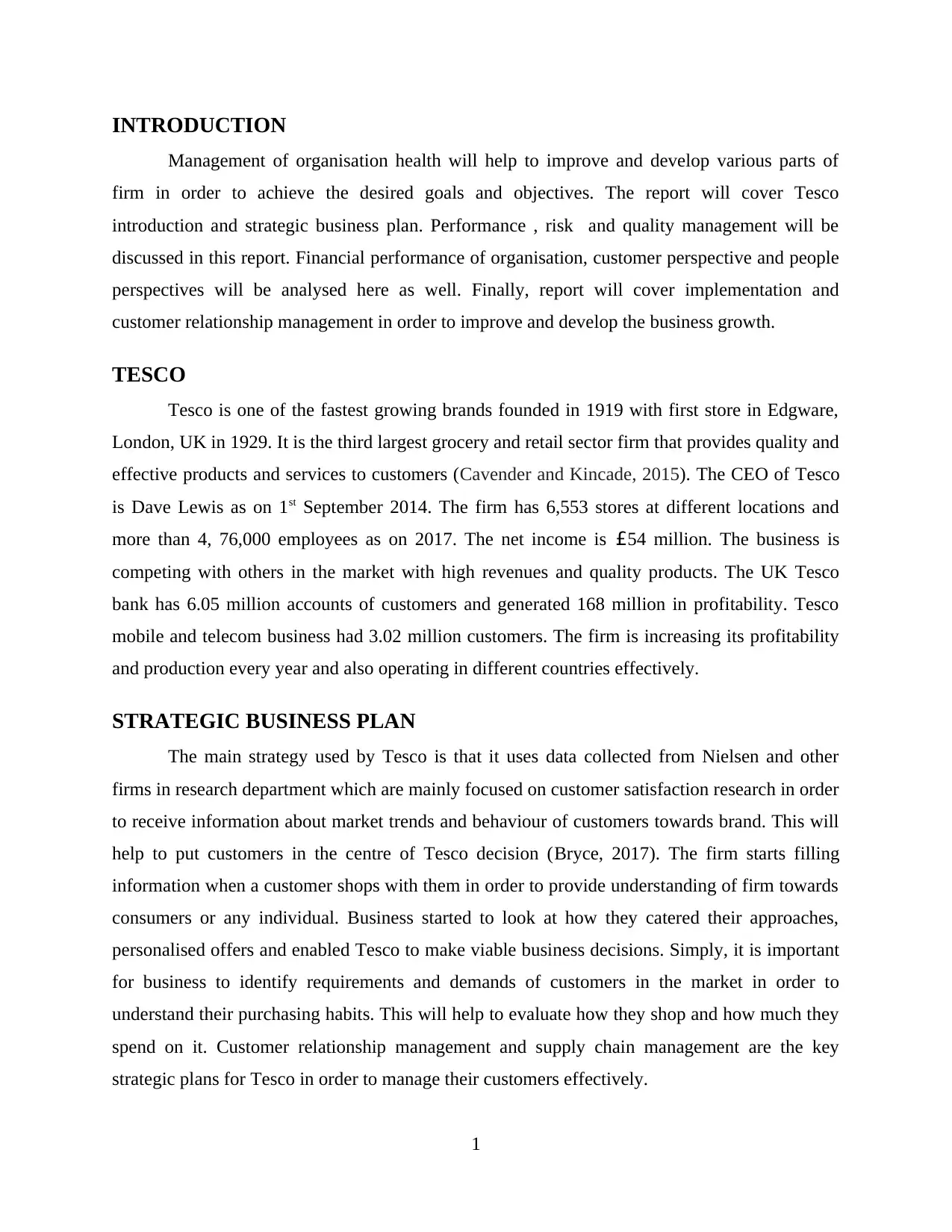
INTRODUCTION
Management of organisation health will help to improve and develop various parts of
firm in order to achieve the desired goals and objectives. The report will cover Tesco
introduction and strategic business plan. Performance , risk and quality management will be
discussed in this report. Financial performance of organisation, customer perspective and people
perspectives will be analysed here as well. Finally, report will cover implementation and
customer relationship management in order to improve and develop the business growth.
TESCO
Tesco is one of the fastest growing brands founded in 1919 with first store in Edgware,
London, UK in 1929. It is the third largest grocery and retail sector firm that provides quality and
effective products and services to customers (Cavender and Kincade, 2015). The CEO of Tesco
is Dave Lewis as on 1st September 2014. The firm has 6,553 stores at different locations and
more than 4, 76,000 employees as on 2017. The net income is £54 million. The business is
competing with others in the market with high revenues and quality products. The UK Tesco
bank has 6.05 million accounts of customers and generated 168 million in profitability. Tesco
mobile and telecom business had 3.02 million customers. The firm is increasing its profitability
and production every year and also operating in different countries effectively.
STRATEGIC BUSINESS PLAN
The main strategy used by Tesco is that it uses data collected from Nielsen and other
firms in research department which are mainly focused on customer satisfaction research in order
to receive information about market trends and behaviour of customers towards brand. This will
help to put customers in the centre of Tesco decision (Bryce, 2017). The firm starts filling
information when a customer shops with them in order to provide understanding of firm towards
consumers or any individual. Business started to look at how they catered their approaches,
personalised offers and enabled Tesco to make viable business decisions. Simply, it is important
for business to identify requirements and demands of customers in the market in order to
understand their purchasing habits. This will help to evaluate how they shop and how much they
spend on it. Customer relationship management and supply chain management are the key
strategic plans for Tesco in order to manage their customers effectively.
1
Management of organisation health will help to improve and develop various parts of
firm in order to achieve the desired goals and objectives. The report will cover Tesco
introduction and strategic business plan. Performance , risk and quality management will be
discussed in this report. Financial performance of organisation, customer perspective and people
perspectives will be analysed here as well. Finally, report will cover implementation and
customer relationship management in order to improve and develop the business growth.
TESCO
Tesco is one of the fastest growing brands founded in 1919 with first store in Edgware,
London, UK in 1929. It is the third largest grocery and retail sector firm that provides quality and
effective products and services to customers (Cavender and Kincade, 2015). The CEO of Tesco
is Dave Lewis as on 1st September 2014. The firm has 6,553 stores at different locations and
more than 4, 76,000 employees as on 2017. The net income is £54 million. The business is
competing with others in the market with high revenues and quality products. The UK Tesco
bank has 6.05 million accounts of customers and generated 168 million in profitability. Tesco
mobile and telecom business had 3.02 million customers. The firm is increasing its profitability
and production every year and also operating in different countries effectively.
STRATEGIC BUSINESS PLAN
The main strategy used by Tesco is that it uses data collected from Nielsen and other
firms in research department which are mainly focused on customer satisfaction research in order
to receive information about market trends and behaviour of customers towards brand. This will
help to put customers in the centre of Tesco decision (Bryce, 2017). The firm starts filling
information when a customer shops with them in order to provide understanding of firm towards
consumers or any individual. Business started to look at how they catered their approaches,
personalised offers and enabled Tesco to make viable business decisions. Simply, it is important
for business to identify requirements and demands of customers in the market in order to
understand their purchasing habits. This will help to evaluate how they shop and how much they
spend on it. Customer relationship management and supply chain management are the key
strategic plans for Tesco in order to manage their customers effectively.
1
⊘ This is a preview!⊘
Do you want full access?
Subscribe today to unlock all pages.

Trusted by 1+ million students worldwide
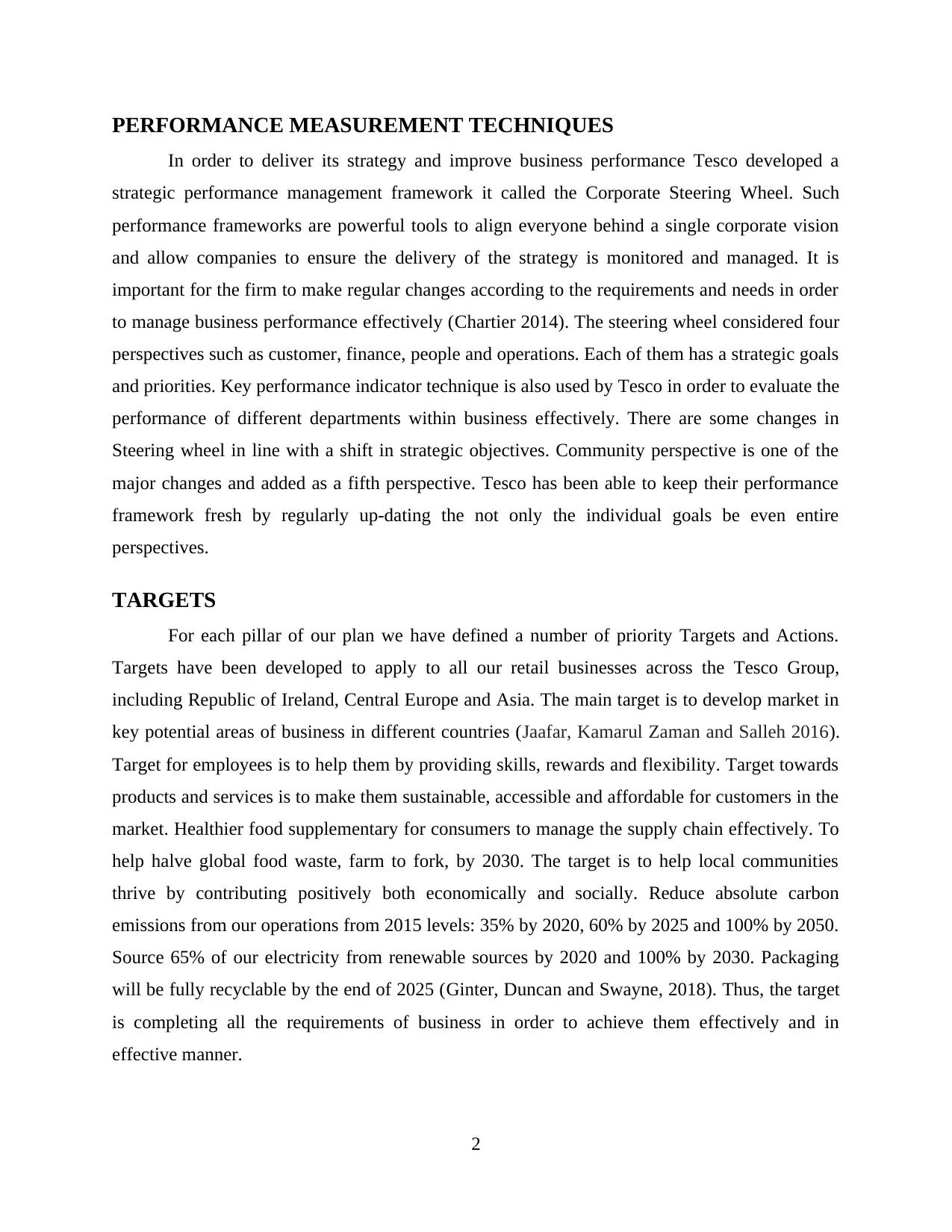
PERFORMANCE MEASUREMENT TECHNIQUES
In order to deliver its strategy and improve business performance Tesco developed a
strategic performance management framework it called the Corporate Steering Wheel. Such
performance frameworks are powerful tools to align everyone behind a single corporate vision
and allow companies to ensure the delivery of the strategy is monitored and managed. It is
important for the firm to make regular changes according to the requirements and needs in order
to manage business performance effectively (Chartier 2014). The steering wheel considered four
perspectives such as customer, finance, people and operations. Each of them has a strategic goals
and priorities. Key performance indicator technique is also used by Tesco in order to evaluate the
performance of different departments within business effectively. There are some changes in
Steering wheel in line with a shift in strategic objectives. Community perspective is one of the
major changes and added as a fifth perspective. Tesco has been able to keep their performance
framework fresh by regularly up-dating the not only the individual goals be even entire
perspectives.
TARGETS
For each pillar of our plan we have defined a number of priority Targets and Actions.
Targets have been developed to apply to all our retail businesses across the Tesco Group,
including Republic of Ireland, Central Europe and Asia. The main target is to develop market in
key potential areas of business in different countries (Jaafar, Kamarul Zaman and Salleh 2016).
Target for employees is to help them by providing skills, rewards and flexibility. Target towards
products and services is to make them sustainable, accessible and affordable for customers in the
market. Healthier food supplementary for consumers to manage the supply chain effectively. To
help halve global food waste, farm to fork, by 2030. The target is to help local communities
thrive by contributing positively both economically and socially. Reduce absolute carbon
emissions from our operations from 2015 levels: 35% by 2020, 60% by 2025 and 100% by 2050.
Source 65% of our electricity from renewable sources by 2020 and 100% by 2030. Packaging
will be fully recyclable by the end of 2025 (Ginter, Duncan and Swayne, 2018). Thus, the target
is completing all the requirements of business in order to achieve them effectively and in
effective manner.
2
In order to deliver its strategy and improve business performance Tesco developed a
strategic performance management framework it called the Corporate Steering Wheel. Such
performance frameworks are powerful tools to align everyone behind a single corporate vision
and allow companies to ensure the delivery of the strategy is monitored and managed. It is
important for the firm to make regular changes according to the requirements and needs in order
to manage business performance effectively (Chartier 2014). The steering wheel considered four
perspectives such as customer, finance, people and operations. Each of them has a strategic goals
and priorities. Key performance indicator technique is also used by Tesco in order to evaluate the
performance of different departments within business effectively. There are some changes in
Steering wheel in line with a shift in strategic objectives. Community perspective is one of the
major changes and added as a fifth perspective. Tesco has been able to keep their performance
framework fresh by regularly up-dating the not only the individual goals be even entire
perspectives.
TARGETS
For each pillar of our plan we have defined a number of priority Targets and Actions.
Targets have been developed to apply to all our retail businesses across the Tesco Group,
including Republic of Ireland, Central Europe and Asia. The main target is to develop market in
key potential areas of business in different countries (Jaafar, Kamarul Zaman and Salleh 2016).
Target for employees is to help them by providing skills, rewards and flexibility. Target towards
products and services is to make them sustainable, accessible and affordable for customers in the
market. Healthier food supplementary for consumers to manage the supply chain effectively. To
help halve global food waste, farm to fork, by 2030. The target is to help local communities
thrive by contributing positively both economically and socially. Reduce absolute carbon
emissions from our operations from 2015 levels: 35% by 2020, 60% by 2025 and 100% by 2050.
Source 65% of our electricity from renewable sources by 2020 and 100% by 2030. Packaging
will be fully recyclable by the end of 2025 (Ginter, Duncan and Swayne, 2018). Thus, the target
is completing all the requirements of business in order to achieve them effectively and in
effective manner.
2
Paraphrase This Document
Need a fresh take? Get an instant paraphrase of this document with our AI Paraphraser
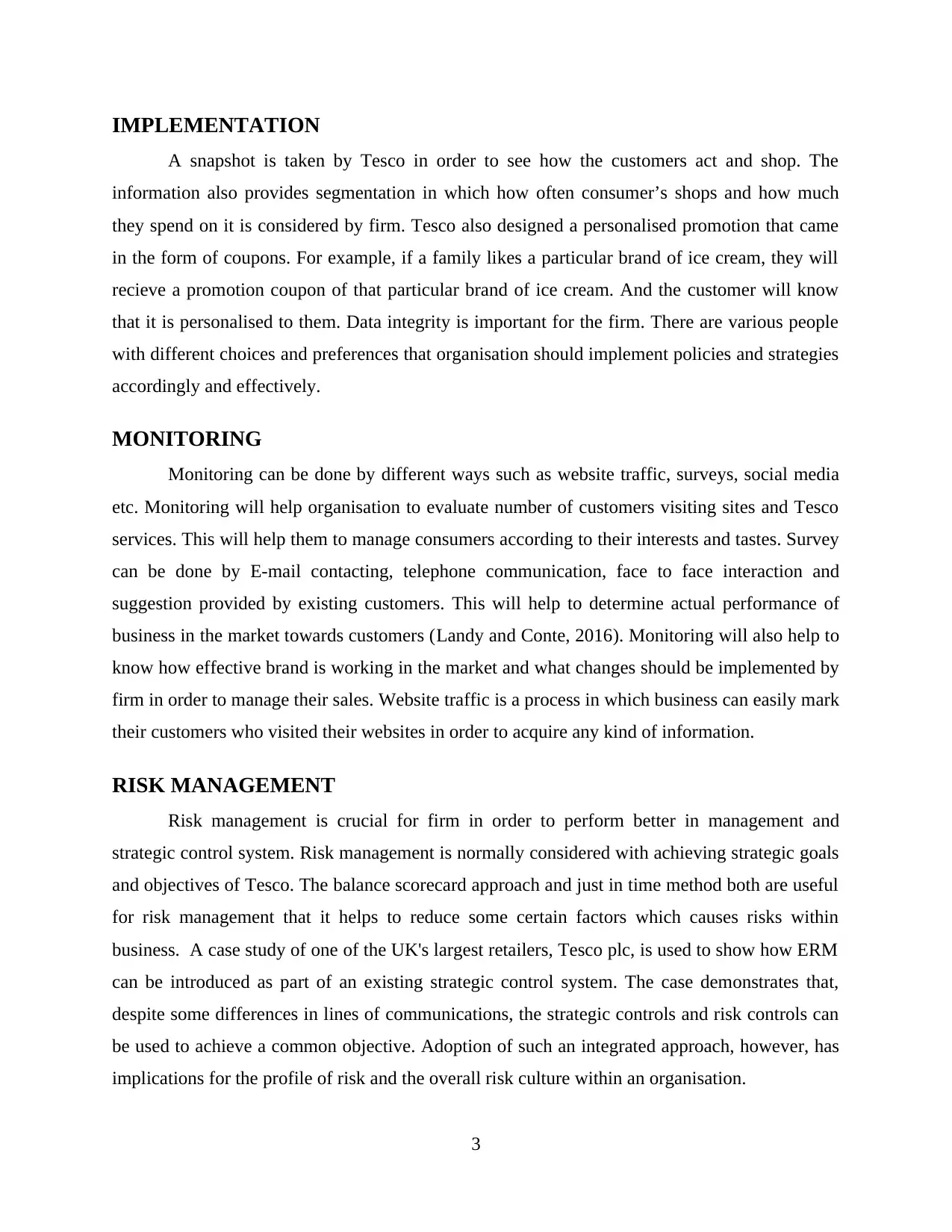
IMPLEMENTATION
A snapshot is taken by Tesco in order to see how the customers act and shop. The
information also provides segmentation in which how often consumer’s shops and how much
they spend on it is considered by firm. Tesco also designed a personalised promotion that came
in the form of coupons. For example, if a family likes a particular brand of ice cream, they will
recieve a promotion coupon of that particular brand of ice cream. And the customer will know
that it is personalised to them. Data integrity is important for the firm. There are various people
with different choices and preferences that organisation should implement policies and strategies
accordingly and effectively.
MONITORING
Monitoring can be done by different ways such as website traffic, surveys, social media
etc. Monitoring will help organisation to evaluate number of customers visiting sites and Tesco
services. This will help them to manage consumers according to their interests and tastes. Survey
can be done by E-mail contacting, telephone communication, face to face interaction and
suggestion provided by existing customers. This will help to determine actual performance of
business in the market towards customers (Landy and Conte, 2016). Monitoring will also help to
know how effective brand is working in the market and what changes should be implemented by
firm in order to manage their sales. Website traffic is a process in which business can easily mark
their customers who visited their websites in order to acquire any kind of information.
RISK MANAGEMENT
Risk management is crucial for firm in order to perform better in management and
strategic control system. Risk management is normally considered with achieving strategic goals
and objectives of Tesco. The balance scorecard approach and just in time method both are useful
for risk management that it helps to reduce some certain factors which causes risks within
business. A case study of one of the UK's largest retailers, Tesco plc, is used to show how ERM
can be introduced as part of an existing strategic control system. The case demonstrates that,
despite some differences in lines of communications, the strategic controls and risk controls can
be used to achieve a common objective. Adoption of such an integrated approach, however, has
implications for the profile of risk and the overall risk culture within an organisation.
3
A snapshot is taken by Tesco in order to see how the customers act and shop. The
information also provides segmentation in which how often consumer’s shops and how much
they spend on it is considered by firm. Tesco also designed a personalised promotion that came
in the form of coupons. For example, if a family likes a particular brand of ice cream, they will
recieve a promotion coupon of that particular brand of ice cream. And the customer will know
that it is personalised to them. Data integrity is important for the firm. There are various people
with different choices and preferences that organisation should implement policies and strategies
accordingly and effectively.
MONITORING
Monitoring can be done by different ways such as website traffic, surveys, social media
etc. Monitoring will help organisation to evaluate number of customers visiting sites and Tesco
services. This will help them to manage consumers according to their interests and tastes. Survey
can be done by E-mail contacting, telephone communication, face to face interaction and
suggestion provided by existing customers. This will help to determine actual performance of
business in the market towards customers (Landy and Conte, 2016). Monitoring will also help to
know how effective brand is working in the market and what changes should be implemented by
firm in order to manage their sales. Website traffic is a process in which business can easily mark
their customers who visited their websites in order to acquire any kind of information.
RISK MANAGEMENT
Risk management is crucial for firm in order to perform better in management and
strategic control system. Risk management is normally considered with achieving strategic goals
and objectives of Tesco. The balance scorecard approach and just in time method both are useful
for risk management that it helps to reduce some certain factors which causes risks within
business. A case study of one of the UK's largest retailers, Tesco plc, is used to show how ERM
can be introduced as part of an existing strategic control system. The case demonstrates that,
despite some differences in lines of communications, the strategic controls and risk controls can
be used to achieve a common objective. Adoption of such an integrated approach, however, has
implications for the profile of risk and the overall risk culture within an organisation.
3
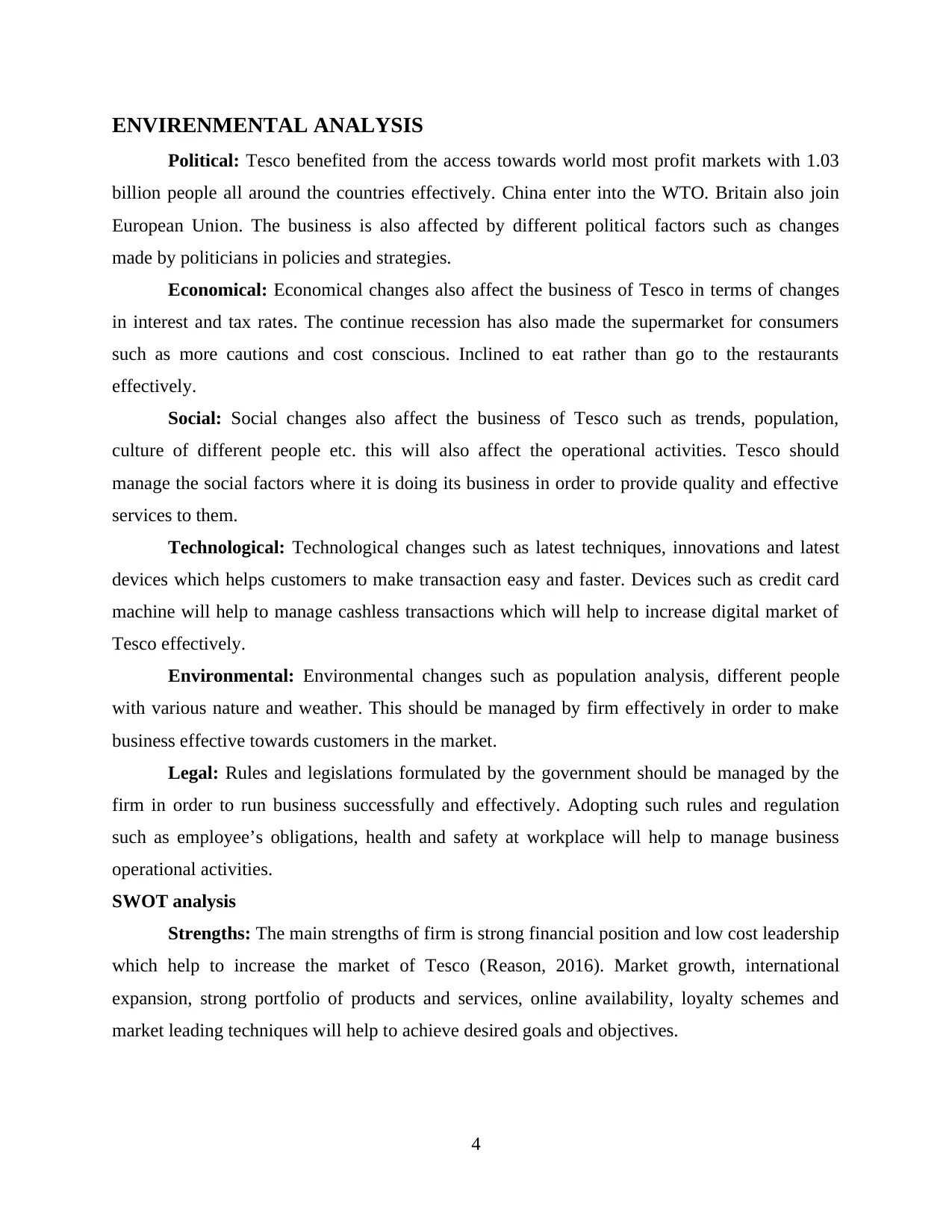
ENVIRENMENTAL ANALYSIS
Political: Tesco benefited from the access towards world most profit markets with 1.03
billion people all around the countries effectively. China enter into the WTO. Britain also join
European Union. The business is also affected by different political factors such as changes
made by politicians in policies and strategies.
Economical: Economical changes also affect the business of Tesco in terms of changes
in interest and tax rates. The continue recession has also made the supermarket for consumers
such as more cautions and cost conscious. Inclined to eat rather than go to the restaurants
effectively.
Social: Social changes also affect the business of Tesco such as trends, population,
culture of different people etc. this will also affect the operational activities. Tesco should
manage the social factors where it is doing its business in order to provide quality and effective
services to them.
Technological: Technological changes such as latest techniques, innovations and latest
devices which helps customers to make transaction easy and faster. Devices such as credit card
machine will help to manage cashless transactions which will help to increase digital market of
Tesco effectively.
Environmental: Environmental changes such as population analysis, different people
with various nature and weather. This should be managed by firm effectively in order to make
business effective towards customers in the market.
Legal: Rules and legislations formulated by the government should be managed by the
firm in order to run business successfully and effectively. Adopting such rules and regulation
such as employee’s obligations, health and safety at workplace will help to manage business
operational activities.
SWOT analysis
Strengths: The main strengths of firm is strong financial position and low cost leadership
which help to increase the market of Tesco (Reason, 2016). Market growth, international
expansion, strong portfolio of products and services, online availability, loyalty schemes and
market leading techniques will help to achieve desired goals and objectives.
4
Political: Tesco benefited from the access towards world most profit markets with 1.03
billion people all around the countries effectively. China enter into the WTO. Britain also join
European Union. The business is also affected by different political factors such as changes
made by politicians in policies and strategies.
Economical: Economical changes also affect the business of Tesco in terms of changes
in interest and tax rates. The continue recession has also made the supermarket for consumers
such as more cautions and cost conscious. Inclined to eat rather than go to the restaurants
effectively.
Social: Social changes also affect the business of Tesco such as trends, population,
culture of different people etc. this will also affect the operational activities. Tesco should
manage the social factors where it is doing its business in order to provide quality and effective
services to them.
Technological: Technological changes such as latest techniques, innovations and latest
devices which helps customers to make transaction easy and faster. Devices such as credit card
machine will help to manage cashless transactions which will help to increase digital market of
Tesco effectively.
Environmental: Environmental changes such as population analysis, different people
with various nature and weather. This should be managed by firm effectively in order to make
business effective towards customers in the market.
Legal: Rules and legislations formulated by the government should be managed by the
firm in order to run business successfully and effectively. Adopting such rules and regulation
such as employee’s obligations, health and safety at workplace will help to manage business
operational activities.
SWOT analysis
Strengths: The main strengths of firm is strong financial position and low cost leadership
which help to increase the market of Tesco (Reason, 2016). Market growth, international
expansion, strong portfolio of products and services, online availability, loyalty schemes and
market leading techniques will help to achieve desired goals and objectives.
4
⊘ This is a preview!⊘
Do you want full access?
Subscribe today to unlock all pages.

Trusted by 1+ million students worldwide
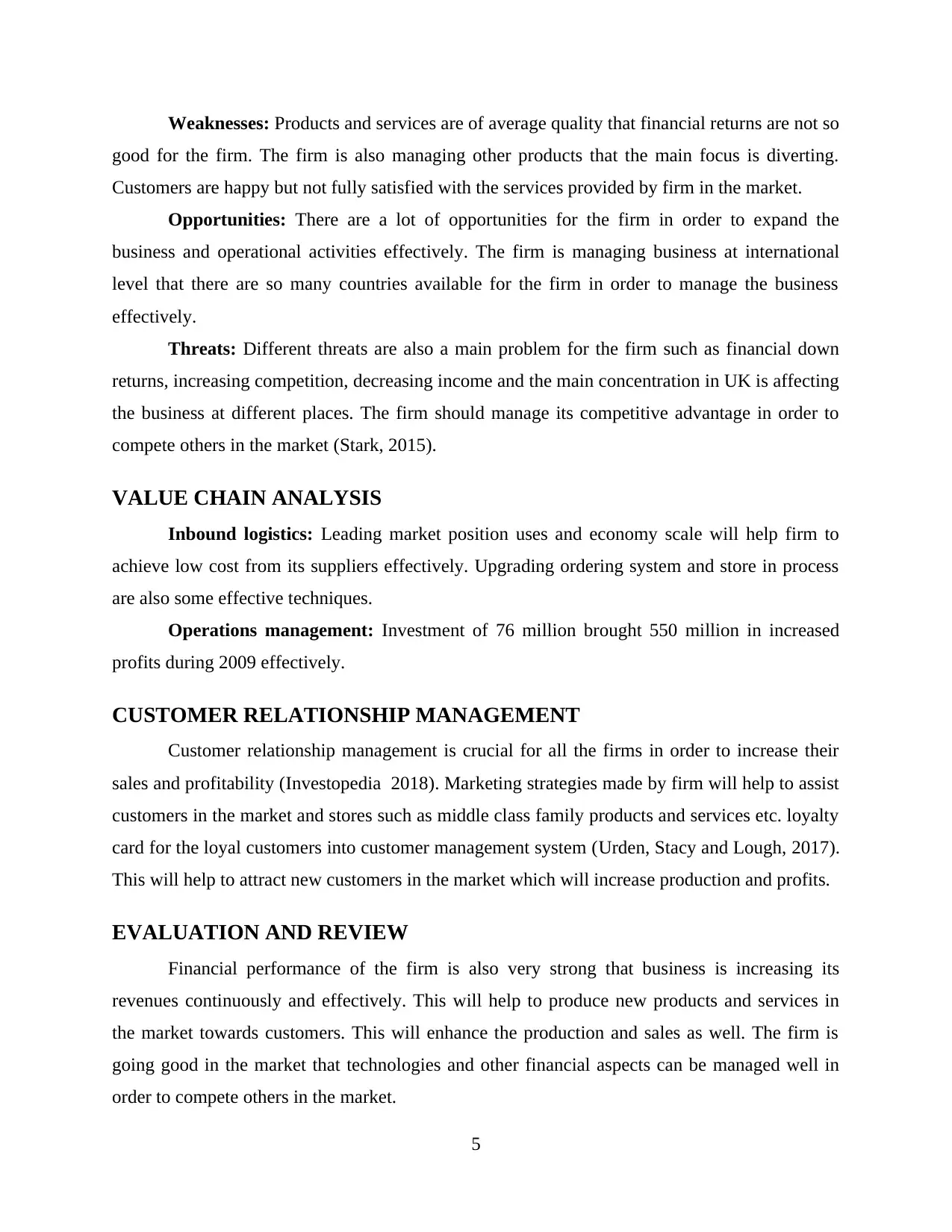
Weaknesses: Products and services are of average quality that financial returns are not so
good for the firm. The firm is also managing other products that the main focus is diverting.
Customers are happy but not fully satisfied with the services provided by firm in the market.
Opportunities: There are a lot of opportunities for the firm in order to expand the
business and operational activities effectively. The firm is managing business at international
level that there are so many countries available for the firm in order to manage the business
effectively.
Threats: Different threats are also a main problem for the firm such as financial down
returns, increasing competition, decreasing income and the main concentration in UK is affecting
the business at different places. The firm should manage its competitive advantage in order to
compete others in the market (Stark, 2015).
VALUE CHAIN ANALYSIS
Inbound logistics: Leading market position uses and economy scale will help firm to
achieve low cost from its suppliers effectively. Upgrading ordering system and store in process
are also some effective techniques.
Operations management: Investment of 76 million brought 550 million in increased
profits during 2009 effectively.
CUSTOMER RELATIONSHIP MANAGEMENT
Customer relationship management is crucial for all the firms in order to increase their
sales and profitability (Investopedia 2018). Marketing strategies made by firm will help to assist
customers in the market and stores such as middle class family products and services etc. loyalty
card for the loyal customers into customer management system (Urden, Stacy and Lough, 2017).
This will help to attract new customers in the market which will increase production and profits.
EVALUATION AND REVIEW
Financial performance of the firm is also very strong that business is increasing its
revenues continuously and effectively. This will help to produce new products and services in
the market towards customers. This will enhance the production and sales as well. The firm is
going good in the market that technologies and other financial aspects can be managed well in
order to compete others in the market.
5
good for the firm. The firm is also managing other products that the main focus is diverting.
Customers are happy but not fully satisfied with the services provided by firm in the market.
Opportunities: There are a lot of opportunities for the firm in order to expand the
business and operational activities effectively. The firm is managing business at international
level that there are so many countries available for the firm in order to manage the business
effectively.
Threats: Different threats are also a main problem for the firm such as financial down
returns, increasing competition, decreasing income and the main concentration in UK is affecting
the business at different places. The firm should manage its competitive advantage in order to
compete others in the market (Stark, 2015).
VALUE CHAIN ANALYSIS
Inbound logistics: Leading market position uses and economy scale will help firm to
achieve low cost from its suppliers effectively. Upgrading ordering system and store in process
are also some effective techniques.
Operations management: Investment of 76 million brought 550 million in increased
profits during 2009 effectively.
CUSTOMER RELATIONSHIP MANAGEMENT
Customer relationship management is crucial for all the firms in order to increase their
sales and profitability (Investopedia 2018). Marketing strategies made by firm will help to assist
customers in the market and stores such as middle class family products and services etc. loyalty
card for the loyal customers into customer management system (Urden, Stacy and Lough, 2017).
This will help to attract new customers in the market which will increase production and profits.
EVALUATION AND REVIEW
Financial performance of the firm is also very strong that business is increasing its
revenues continuously and effectively. This will help to produce new products and services in
the market towards customers. This will enhance the production and sales as well. The firm is
going good in the market that technologies and other financial aspects can be managed well in
order to compete others in the market.
5
Paraphrase This Document
Need a fresh take? Get an instant paraphrase of this document with our AI Paraphraser
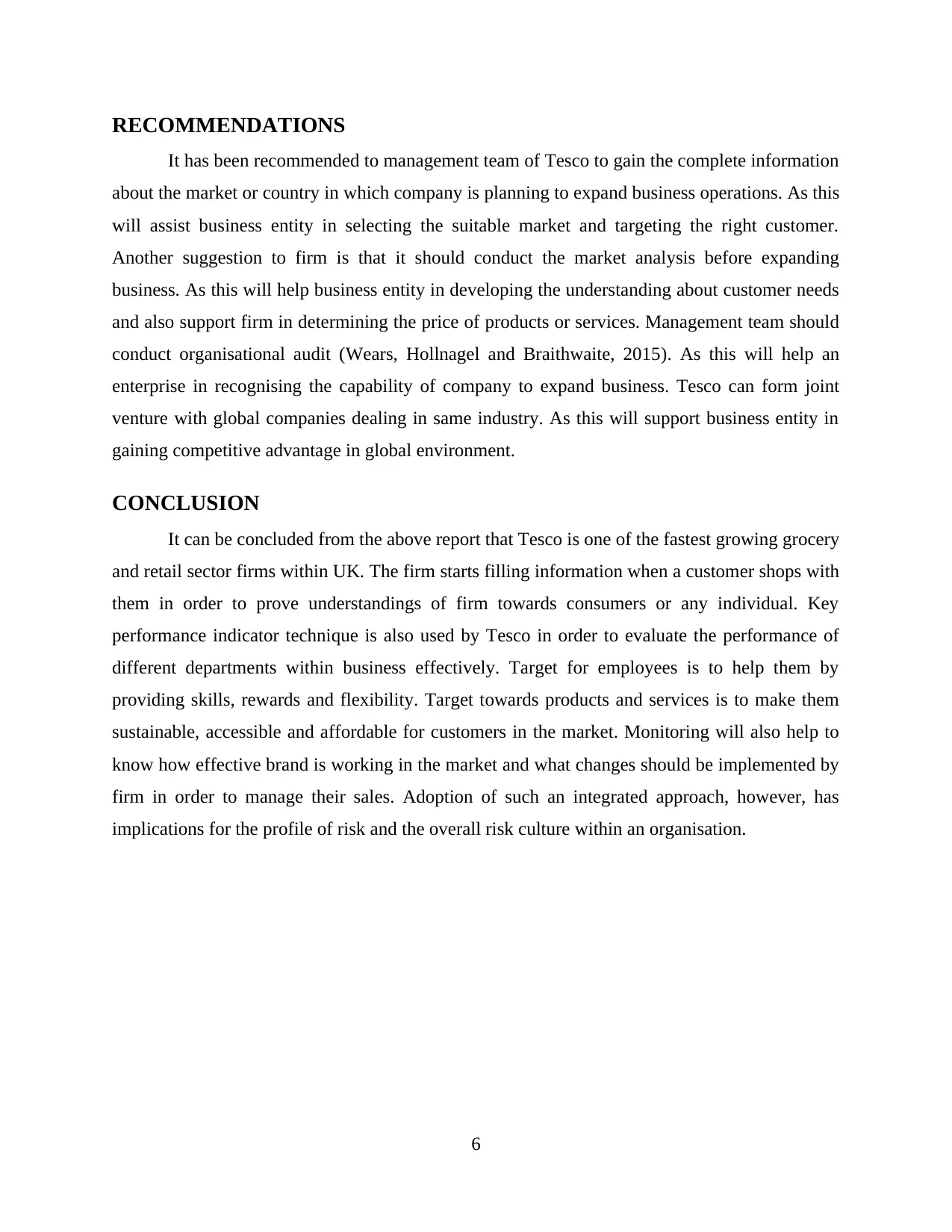
RECOMMENDATIONS
It has been recommended to management team of Tesco to gain the complete information
about the market or country in which company is planning to expand business operations. As this
will assist business entity in selecting the suitable market and targeting the right customer.
Another suggestion to firm is that it should conduct the market analysis before expanding
business. As this will help business entity in developing the understanding about customer needs
and also support firm in determining the price of products or services. Management team should
conduct organisational audit (Wears, Hollnagel and Braithwaite, 2015). As this will help an
enterprise in recognising the capability of company to expand business. Tesco can form joint
venture with global companies dealing in same industry. As this will support business entity in
gaining competitive advantage in global environment.
CONCLUSION
It can be concluded from the above report that Tesco is one of the fastest growing grocery
and retail sector firms within UK. The firm starts filling information when a customer shops with
them in order to prove understandings of firm towards consumers or any individual. Key
performance indicator technique is also used by Tesco in order to evaluate the performance of
different departments within business effectively. Target for employees is to help them by
providing skills, rewards and flexibility. Target towards products and services is to make them
sustainable, accessible and affordable for customers in the market. Monitoring will also help to
know how effective brand is working in the market and what changes should be implemented by
firm in order to manage their sales. Adoption of such an integrated approach, however, has
implications for the profile of risk and the overall risk culture within an organisation.
6
It has been recommended to management team of Tesco to gain the complete information
about the market or country in which company is planning to expand business operations. As this
will assist business entity in selecting the suitable market and targeting the right customer.
Another suggestion to firm is that it should conduct the market analysis before expanding
business. As this will help business entity in developing the understanding about customer needs
and also support firm in determining the price of products or services. Management team should
conduct organisational audit (Wears, Hollnagel and Braithwaite, 2015). As this will help an
enterprise in recognising the capability of company to expand business. Tesco can form joint
venture with global companies dealing in same industry. As this will support business entity in
gaining competitive advantage in global environment.
CONCLUSION
It can be concluded from the above report that Tesco is one of the fastest growing grocery
and retail sector firms within UK. The firm starts filling information when a customer shops with
them in order to prove understandings of firm towards consumers or any individual. Key
performance indicator technique is also used by Tesco in order to evaluate the performance of
different departments within business effectively. Target for employees is to help them by
providing skills, rewards and flexibility. Target towards products and services is to make them
sustainable, accessible and affordable for customers in the market. Monitoring will also help to
know how effective brand is working in the market and what changes should be implemented by
firm in order to manage their sales. Adoption of such an integrated approach, however, has
implications for the profile of risk and the overall risk culture within an organisation.
6
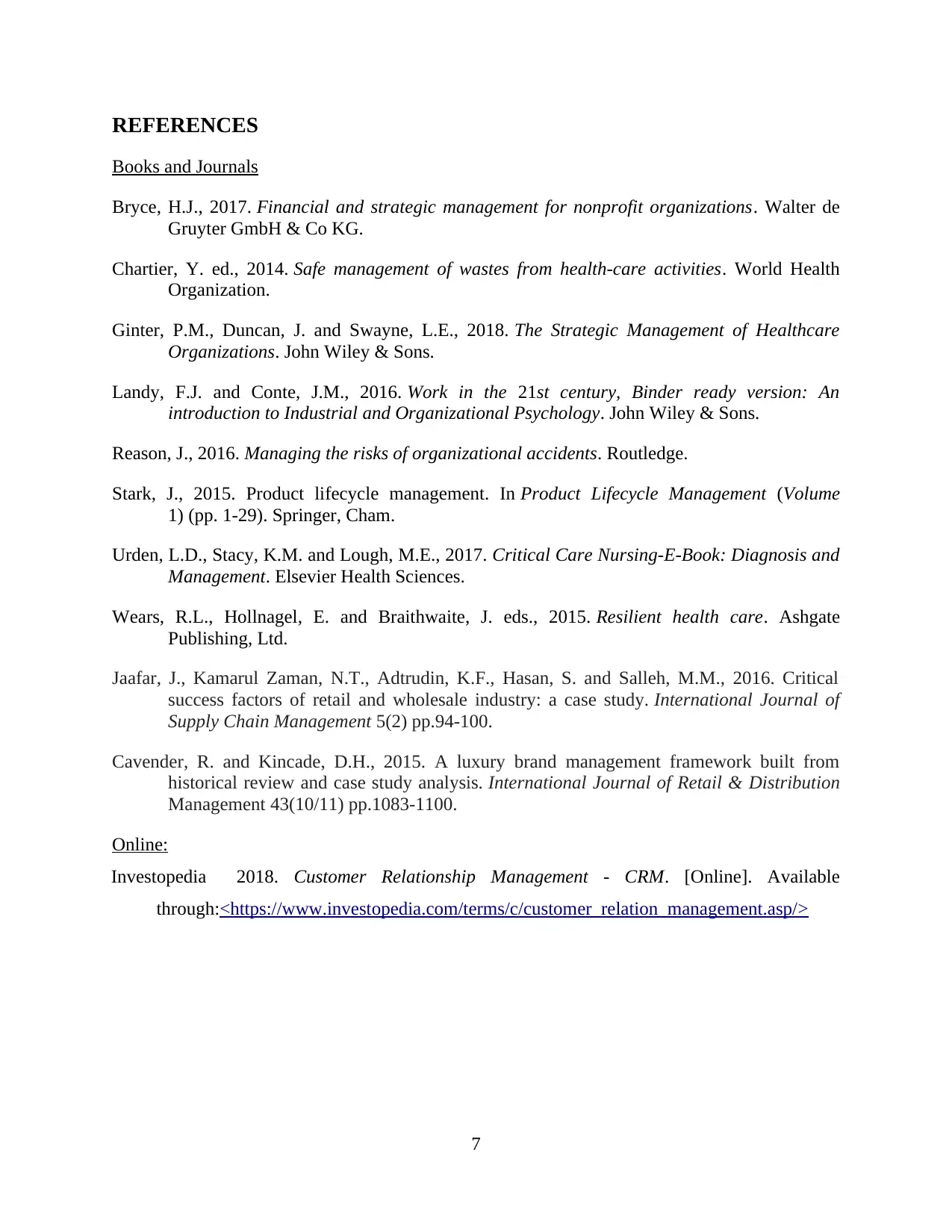
REFERENCES
Books and Journals
Bryce, H.J., 2017. Financial and strategic management for nonprofit organizations. Walter de
Gruyter GmbH & Co KG.
Chartier, Y. ed., 2014. Safe management of wastes from health-care activities. World Health
Organization.
Ginter, P.M., Duncan, J. and Swayne, L.E., 2018. The Strategic Management of Healthcare
Organizations. John Wiley & Sons.
Landy, F.J. and Conte, J.M., 2016. Work in the 21st century, Binder ready version: An
introduction to Industrial and Organizational Psychology. John Wiley & Sons.
Reason, J., 2016. Managing the risks of organizational accidents. Routledge.
Stark, J., 2015. Product lifecycle management. In Product Lifecycle Management (Volume
1) (pp. 1-29). Springer, Cham.
Urden, L.D., Stacy, K.M. and Lough, M.E., 2017. Critical Care Nursing-E-Book: Diagnosis and
Management. Elsevier Health Sciences.
Wears, R.L., Hollnagel, E. and Braithwaite, J. eds., 2015. Resilient health care. Ashgate
Publishing, Ltd.
Jaafar, J., Kamarul Zaman, N.T., Adtrudin, K.F., Hasan, S. and Salleh, M.M., 2016. Critical
success factors of retail and wholesale industry: a case study. International Journal of
Supply Chain Management 5(2) pp.94-100.
Cavender, R. and Kincade, D.H., 2015. A luxury brand management framework built from
historical review and case study analysis. International Journal of Retail & Distribution
Management 43(10/11) pp.1083-1100.
Online:
Investopedia 2018. Customer Relationship Management - CRM. [Online]. Available
through:<https://www.investopedia.com/terms/c/customer_relation_management.asp/>
7
Books and Journals
Bryce, H.J., 2017. Financial and strategic management for nonprofit organizations. Walter de
Gruyter GmbH & Co KG.
Chartier, Y. ed., 2014. Safe management of wastes from health-care activities. World Health
Organization.
Ginter, P.M., Duncan, J. and Swayne, L.E., 2018. The Strategic Management of Healthcare
Organizations. John Wiley & Sons.
Landy, F.J. and Conte, J.M., 2016. Work in the 21st century, Binder ready version: An
introduction to Industrial and Organizational Psychology. John Wiley & Sons.
Reason, J., 2016. Managing the risks of organizational accidents. Routledge.
Stark, J., 2015. Product lifecycle management. In Product Lifecycle Management (Volume
1) (pp. 1-29). Springer, Cham.
Urden, L.D., Stacy, K.M. and Lough, M.E., 2017. Critical Care Nursing-E-Book: Diagnosis and
Management. Elsevier Health Sciences.
Wears, R.L., Hollnagel, E. and Braithwaite, J. eds., 2015. Resilient health care. Ashgate
Publishing, Ltd.
Jaafar, J., Kamarul Zaman, N.T., Adtrudin, K.F., Hasan, S. and Salleh, M.M., 2016. Critical
success factors of retail and wholesale industry: a case study. International Journal of
Supply Chain Management 5(2) pp.94-100.
Cavender, R. and Kincade, D.H., 2015. A luxury brand management framework built from
historical review and case study analysis. International Journal of Retail & Distribution
Management 43(10/11) pp.1083-1100.
Online:
Investopedia 2018. Customer Relationship Management - CRM. [Online]. Available
through:<https://www.investopedia.com/terms/c/customer_relation_management.asp/>
7
⊘ This is a preview!⊘
Do you want full access?
Subscribe today to unlock all pages.

Trusted by 1+ million students worldwide
1 out of 9
Related Documents
Your All-in-One AI-Powered Toolkit for Academic Success.
+13062052269
info@desklib.com
Available 24*7 on WhatsApp / Email
![[object Object]](/_next/static/media/star-bottom.7253800d.svg)
Unlock your academic potential
Copyright © 2020–2026 A2Z Services. All Rights Reserved. Developed and managed by ZUCOL.



